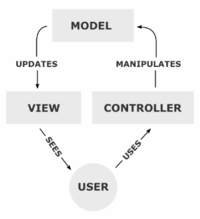CSC/ECE 517 Spring 2013/ch1a 1b mh
Ruby CRUD - Update and Destroy
Introduction
Modern application delivery has undergone drastic changes in recent years, and the introduction of SaaS, or Software-as-a-Service, provides a way for software to be provided "on demand" to a user as needed. Essentially, what this means, is that users interact with a given application through a web based interface referred to as a "thin client", and another computer actually performs the applications computational tasks. The thin client is primarly tasked with displaying the application interface, and relaying the users actions back to the primary computational unit. Such a delivery model has many advantages, such as eliminating the need to install an application locally, and reducing the computational demand on the local client. In addition, this allows the hosting computer to provide an indeterminate number of interfaces to multiple users, as well as being able to free the resources used supplying the service once the user no longer needs them. The architecture used for many SaaS solutions is based on the "Model-View-Controller" architecture. This architecture is modular, easily expandable, very flexible, and many solutions have been created to help software engineers develop SaaS enviornments and by extension the delivery methods needed to produce these products. This article is primarily focused on the development suite, Ruby on Rails, and in particular, 2 types of actions used by this software.
Rails is a framework application development suite for SaaS development, based on the object-oriented language, Ruby, and based on the afore-mentioned Model-View-Controller architecture. Rails favors the axiom of "convention over configuration", and developers are encouraged to learn the conventions of Rails, and let the framework handle the actual implementation, an approach which greatly increases software development productivity.
Overview of Model-View-Controller Architecture
The Model–view–controller architecture is a software design pattern which separates the actual representation of data from the user's interaction with it, including both the user's view of the data and the actual input method. The three essential parts of this architecture, in brief, are:
Model: consists of the actual data and the rules for manipulating this data; notifies view of changes.
Controller: provides an interface between the view and the model, prepares the data representation for each of the other 2 components; actual data manipulation.
View: the actual visual representation of the data and interface provided to the user; requests data from the model.
This architecture provides several advantages, including seperation of functionality (also called seperation of concerns), which facilitates easy maintenance, and reusability. Reusability is addressed in one of Rails central axioms: DRY, or Don't Repeat Yourself.
CRUD
Rails development implements a groups of shortcuts for database manipulation referred to as CRUD. CRUD stands for the 4 central actions which can be performed on a database: Create, Read, Update, and Delete,
Edit/Update
Example of code needed for a successful Edit/Update action
locate the object @object = Object.find params(:id) update it @object.update_attributes!(params[:param]) inform of successful update flash[:notice] go to the updated object redirect_to object_path(@object)
Comparison of Update and Create Actions
def edit
@movie = Movie.find params[:id]
end
def update
@movie = Movie.find params[:id]
@movie.update_attributes!(params[:movie])
flash[:notice] = "#{@movie.title} was successfully updated."
redirect_to movie_path(@movie)
end
Destroy
Overview of code actions needed for a successful Delete action
locate the object
@object = Object.find params(:id)
destroy it
@object.destroy
inform of successful update
flash[:notice] = "Object '#{@object.title}' deleted."
go to the updated object
redirect_to object_path(@object)
Pitfalls in MVC Design
Rails encourages code in models, keeping controllers and views thin.
"Fat controllers" trap
Tempatation to put majority of code in controller.
Controllers should be lean as possible.
"Fat views" trap
View should not contain code to sort the view, or conditionally display items - controller.
Controllers and models should so the work. View should ONLY display the current data.
Following these guidelines makes the code easily amenable to SOA (Service-Oriented Architecture); a trivial controller change allows the code to be refactored to respond correctly to XML or JSON.
(JSON = JavaScript Object Notation, XML - eXtensible Markup Language)
Migration to Service Oriented Architecture
Another benefit of thin controllers and views is an easy migration to a Service Oriented Architecture (SOA).
SOA is used in Software As a Service (SAAS) applications. Typically in SOA, another computer, rather than a human user, is accessing the web service. Hence a more efficient method of passing the data from machine to machine is employed. This often takes the form of an XML interface for input/output, which allows direct access to the data instead of using “screen scraping” techniques to convert HTML or other human-readable output into computer-readable data.
In the example code below the non-SOA path does a redirect to HTML which would be the normal way to display the results to the user. An SOA application can be defined by a single line of code which specifies an XML rendering if the client prefers XML.
def create
@movie = Movie.find params[:id]
@movie.update_attributes!(params[:movie])
respond_to do |client_wants|
client_wants.html { redirect_to movie_path(@movie) } # as before
client_wants.xml { render :xml => @movie.to_xml }
end
end
Summary
Rails encourages you to put code.... <==========MORE
Keep in mind the conventions of rails. They will save you a lot of work and ensure fewer bugs. Debugging is tricky, you can use logging or the interactive debugger.
